Digital Clothing Market Insights, 2031
The global digital clothing market was valued at $498.7 million in 2021, and is projected to reach $4.8 billion by 2031, growing at a CAGR of 26.4% from 2022 to 2031.
A computer picture created to closely resemble real-world original apparel might be referred to as "digital clothing." Digital clothing is constructed of no tangible materials, including fabric. Instead of employing fabrics, these clothing are created using computer technology and 3D software. The goal of digital fashion designers is to create, showcase, and evaluate the characteristics of clothing in a virtual setting. Digital fashion design necessitates knowledge of materials science, production technology, ergonomics, and anthropometric measurements in addition to using specialized software and tools.
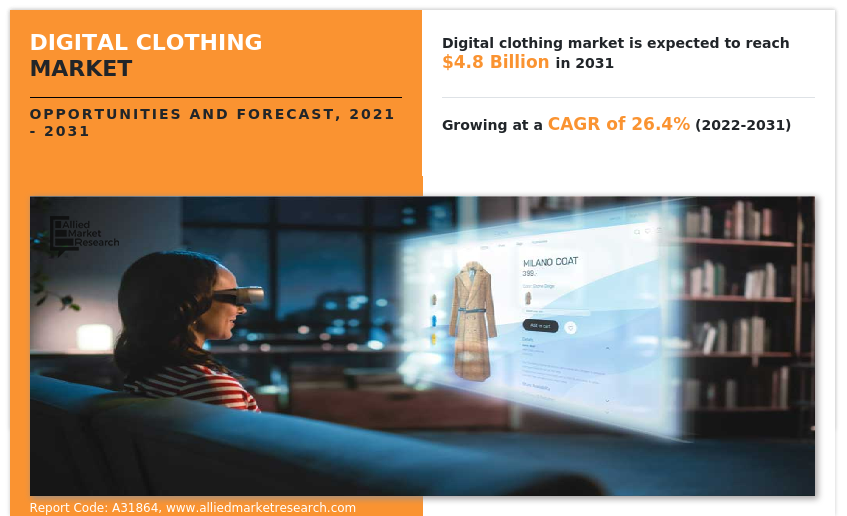
Blockchain technology has already had a revolutionary impact on various aspects of human lives, and this is no less true for the fashion industry. Since 2020, digital fashion has gone from an unknown concept to a rapidly growing industry. The first metaverse fashion week took place this March 2022 showcasing some of the most innovative brands and styles, including Adidas AG, LVMH, H&M Group, Dolce & Gabbana, as well as popular Web 3.0 brands like DRESSX, the Fabricant, and Auroboros.
The digital clothing market is expected to witness notable growth during the forecast period, owing to the rise in the development of the metaverse and the growth in demand for sustainable clothing. Furthermore, the surge in digitalization has driven the growth of the market. However, the high cost of digital garments is the prime factor restraining the market growth. On the contrary, the increase in trend for fast fashion trend and non-fungible tokens (NFTs) and the rapid advancement in the augmented reality (AR) and virtual reality (VR) gaming industry, are expected to propel the digital clothing market growth during the forecast period.
The digital clothing market is segmented into technology, transaction, application area and region. The global digital clothing market research is segmented into technology type, transaction type, application area, and region. On the basis of technology type, the market is categorized into 3D software, blockchain, artificial intelligence (AI), and others. On the basis of the transaction type the market is bifurcated into on-chain and off-chain. On the basis of application area, the digital clothing market is categorized into digital content creation, fashion design & technology, gaming, and others. On the basis of region, the digital clothing market trends are analyzed across North America (the U.S. and Canada), Europe (Germany, Italy, France, Spain, UK, and the Rest of Europe), Asia-Pacific (China, Japan, India, South Korea, Singapore, and Rest of Asia-Pacific), and LAMEA (Latin America, Middle East, and Africa).
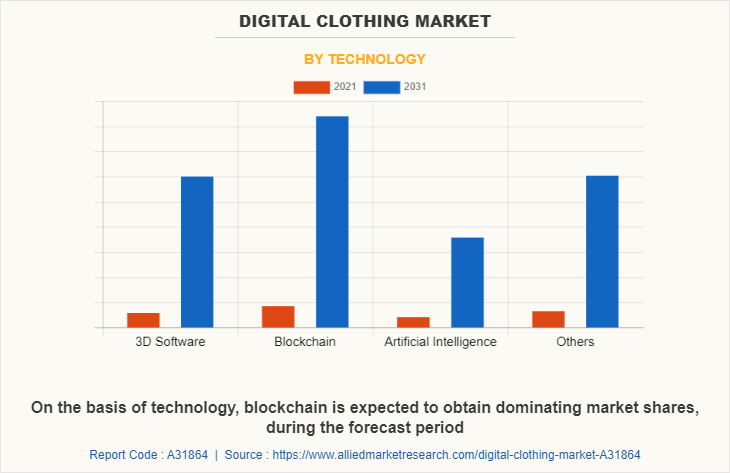
Awareness regarding cost-effective and tailored digital technologies such as WEB 2.0, AI, and metaverse is anticipated to drive the adoption of the digital clothing market. For instance, despite having 100% of their population connected to the internet, Qatar and UAE have a lower level of innovation, which is why these countries have started to invest in the technical adoption of digital reality. Moreover, this region experiences growth prospects during the forecast period as private-sector players are trying their fortune in the development of IT infrastructure, internet penetration, and a rise in wireless device usage. Hence, this would drive many opportunities for the growth of the digital clothing market.
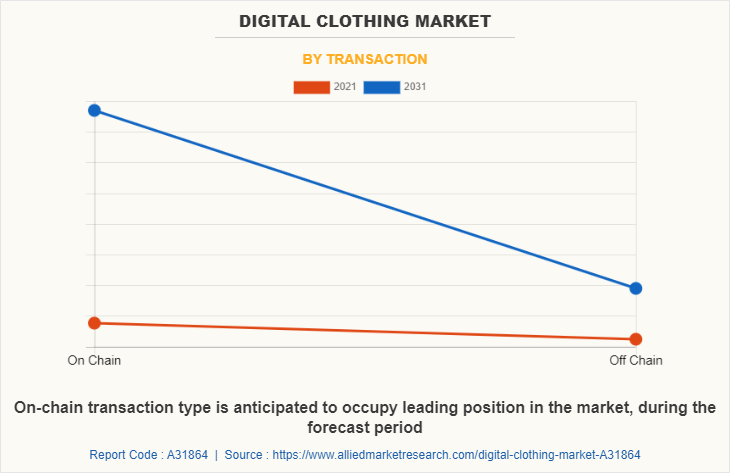
Transactions that take place on a blockchain and are recorded on the distributed, public ledger are referred to as "on-chain" transactions. The transactions that update the global blockchain network are regarded as on-chain transactions since they have been legally verified or authenticated. On-chain transactions are transparent and secure since they are time-stamped and duplicated throughout the whole blockchain network. Furthermore, on-chain transactions are immutable, which makes them impossible to change. This feature contributes to increased security by avoiding a hack in which transaction information might be modified. As a result, it was noted that there has been an increase in use of on-chain transactions in the digital market, which is propels the expansion of the digital clothing industry.
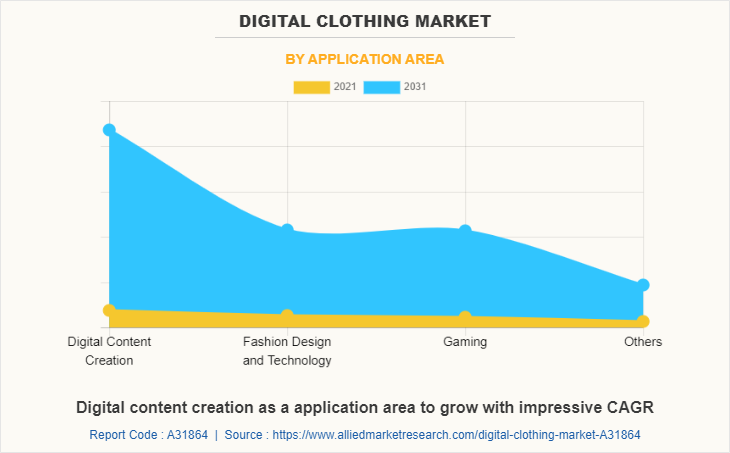
The method of making ideas and gathering information from any mainstream press in specific contexts is known as digital content creation. Digital content creation examples include audio or video files, text, images, and graphics. Furthermore, it enables the business to interact with the people who visit its website, which promotes brand scalability and raises the need for content production. Digital content creation has been playing a vital role in revolving the fashion industry, in terms of trendsetting and transforming the adoption of the digital clothing market.
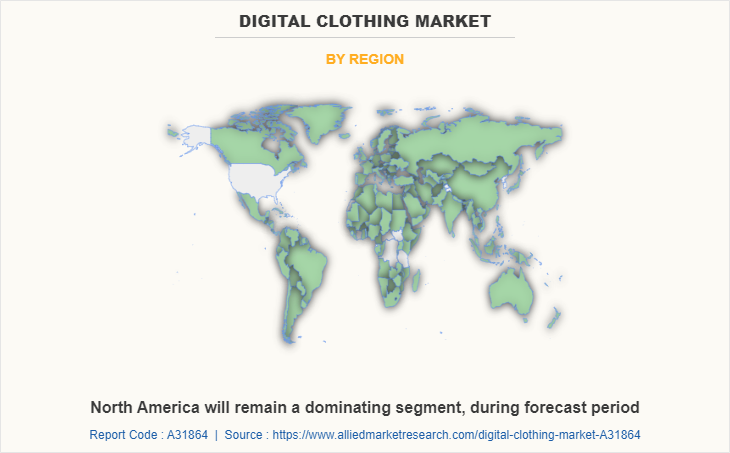
North America dominates the digital clothing market growth as it is one of the most technologically advanced regions in the world. The region includes the U.S. and Canada in addition to other nations with strong and stable economies, enabling major expenditures in R&D activities that enable the development of new technologies like 3D-modelled pixel clothing, or digital clothing. North America is one of the largest regions in terms of the high adoption rate of new advanced technologies, such as AR, VR, AI, and the metaverse. With the aid of cutting-edge technology like artificial intelligence at a reasonable cost-to-serve, many research hubs and institutes in the domain have been attempting to expand the coverage of the metaverse in response to a significant digital clothing product demand. Rise demand for digital human influencers is expected to fuel digital clothing market growth to a major extent in North America. In addition, various U.S.-based market players adopt different methods to increase their product offerings and capabilities such as innovative creations, new launches, and collaborations.
Top Impacting Factors
The market for digital clothing is anticipated to expand significantly during the forecast period, due to the rise in the development of the metaverse, the surge in digitalization, and the growing demand for sustainable clothing. However, the primary factor preventing market expansion is the high cost of digital garments, which limits consumer demand. On the contrary, the increase in trend for fast fashion trends and NFTs and the rapid advancement in AR and VR gaming industry are anticipated to drive the growth of the digital clothing market during the forecast period.
The rise in the development of Metaverse
According to the Forbes report “Rise of Disruptor, 2021” it is stated that the younger generation has influenced the growth of digital asset ownership. The report states that by the third quarter of 2021 digital asset market made $10.7 billion in sales, which is eight times more than in the previous quarter. The major factor propelling the rise in demand for the digital asset market was the interest of an individual in joining the virtual world and the metaverse. Moreover, it was observed that the demand for the ownership of digital assets such as digital clothing and wearable accessories had the maximum share in sales. Such developments in metaverse platforms drive the growth of the digital clothing market.
Competition Analysis
Competitive analysis and profiles of the major digital clothing industry players, such as Adidas AG, Auroboros, Dolce & Gabbana S.r.l., DRESSX, Kering (Gucci), H&M Group, LVMH, Nike, Inc., Replicant, Inc. and The Fabricant are provided in this report.
Key Benefits for Stakeholders
This report provides a quantitative analysis of the digital clothing market size, current trends, estimations, and dynamics of the digital clothing market analysis from 2021 to 2031 to identify the prevailing digital clothing market opportunities.
The market research is offered along with information related to key drivers, restraints, and opportunities.
Porter's five forces analysis highlights the potency of buyers and suppliers to enable stakeholders make profit-oriented business decisions and strengthen their supplier-buyer network.
In-depth analysis of the digital clothing market segmentation assists to determine the prevailing market opportunities.
Major countries in each region are mapped according to their revenue contribution to the global market.
Market player positioning facilitates benchmarking and provides a clear understanding of the present position of the market players along with their digital clothing market share at the global as well as regional levels.
The report includes the analysis of the regional as well as global digital clothing market trends, key players, market segments, application areas, and digital clothing market forecast.
Digital Clothing Market Report Highlights
| Aspects | Details |
| Market Size By 2031 | USD 4.8 billion |
| Growth Rate | CAGR of 26.4% |
| Forecast period | 2021 - 2031 |
| Report Pages | 196 |
| By Technology |
|
| By Transaction |
|
| By Application Area |
|
| By Region |
|
| Key Market Players | Nike, Inc., dolce & gabbana s.r.l., Adidas AG, H&M Group, Auroboros, Replicant, Inc., Kerings (Gucci), The Fabricant, DRESSX, LVMH |
Analyst Review
Digital fashion is highly sustainable upcoming trend. More importantly, it comes with zero creative constraints or production limitations. Fashion going digital means less physical clothing consumption and more immersion into virtual technologies. Digital dressing is the most practical way for shoppers to showcase their digital style. Consumers can actually wear their digital garments by altering photos and using advanced technologies like augmented reality and artificial intelligence. The pandemic brought about the need for virtual expression that gives a richer experience for gamers and metaverse enthusiasts. Digital fashion platforms have also given a more sustainable avenue for fashion influencers.
Key providers in the Digital Clothing market are Adidas AG, Nike, Inc. LVMH, Kering (Gucci), The Fabricant, H&M Group, Dolce & Gabbana S.r.l. and Intel Corporation. Various companies have established partnerships to increase their solutions offerings in 5G network with the growth in demand for digital clothing. For instance, in July 2022, Snapchat has offered a variety of AR filters since its inception. Snapchat has also partnered with companies such as Prada and Ulta to offer customers virtual try-on experiences, which have resulted in substantial sales lifts. Moreover, snapchat has made its proprietary technology free to use to encourage more retailers to adopt AR-powered ecommerce. Now retailers can seamlessly integrate AR try-on technology and Camera Kit of Snapchat into their own mobile apps and websites.
In addition, digital fashion has been most prevalent in gaming, where gamers pay millions of dollars per year to outfit their digital 3D Software in the latest cosmetic skin. Players in gaming platforms like Roblox and Fortnite revel in expressing their personalities through costumes for 3D Software, so it makes sense that digital fashion thrives in gaming events. For instance, in February 2022, Gucci introduced a virtual collection to Roblox. The limited-edition items were quickly snapped up, and reports of virtual bags fetching more money than the real thing on the resale market began popping up, including a Queen Bee Dionysus bag that sold for 350,000 Robux, or more than $4,000. Thein-game currency of Roblox is known as “Robux,” and users can purchase it with cash via their debit card or another form of electronic payment. Each Robux is worth about 100 times the value of a US bill; thus, a gamer would pay $100 cash in exchange for $10,000 Robux.
Digital Clothing is a significant revenue driver for apparel retailers. Brands such as Gucci, Tommy Hilfiger and Dolce & Gabbana have invested millions of dollars in opening virtual metaverse storefronts where they have sold a mix of digital clothing NFTs and NFTs redeemable for physical goods. For instance, in August 2021 Alta Moda show of Dolce & Gabbana in Venice, the Italian fashion duo unveiled Collezione Genesi, a nine-piece NFT – or non-fungible token collection, produced in collaboration with UNXD, a curated marketplace for digital luxury and culture. Five of the Collezione Genesi pieces two dresses, a suit for men, and two crowns are physical creations, designed by Dolce & Gabbana, that have digital versions that can be used in the metaverse.
The estimated industry size of Digital Clothing is US$ 500 million.
Growing demand for sustainable clothing and a surge in digitalization are the upcoming trends in the digital clothing market.
Digital Content Creation, Fashion Design & Technology, and Gaming are the leading application of the Digital Clothing Market.
North America is considered as the largest regional market for Digital Clothing.
Currently, Nike, Inc., LVMH Kering (Gucci), The Fabricant and H&M Group are some of the leading players in the digital clothing market.
Loading Table Of Content...



